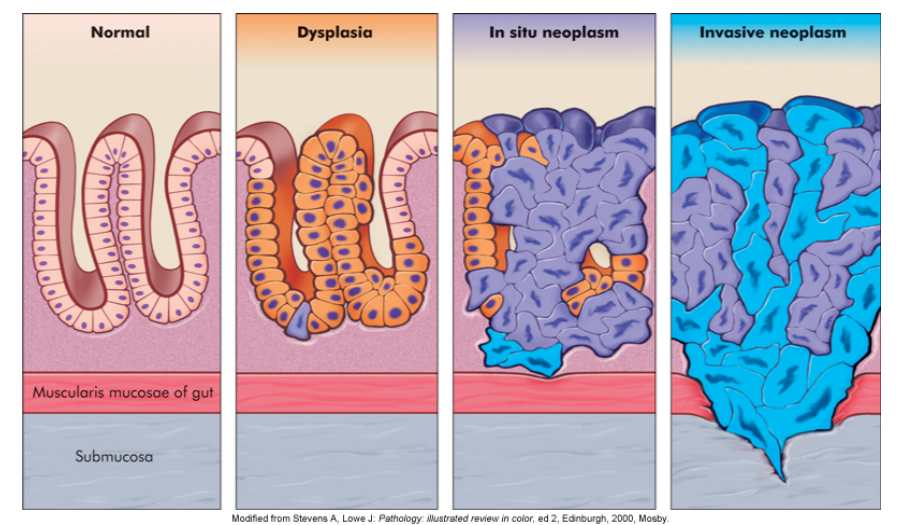
Cancer- Neoplasia
neoplasia: abnormal mass of tissue growth
Hallmarks of Cancer:
self-sufficiency in growth signals
insensitivity to anti-growth signals ( because they don’t have receptors)
evading apoptosis( telomeres)
sustained angiogenesis
limitless replicative potential
invasion and metastasis
escaping immune surveillance (checkpoint inhibitors)
variation in population of cells
heritable: Mutations in DNA, chromosomes, methylation pattern
Terminology
tissue types
carcinoma → epithelial cells
sarcoma → connective tissue
leukemia → circulatory or lymphatic
cell types
adenomatous cells → ductal or glandular cells
squamous cells → flat cells
myeloid → blood cells
Lymphoid → lymphocytes or macrophages
begin vs malignant
benign tumors → suffix “- oma”
except carcinomas + sarcomas + lymphomas
malignant → all other tumors
carcinoma in situ (CIS) → epithelial malignant tumors that have not broken through or invade the surrounding stroma (can be cut out cleanly)

Cancer Progression
stages of malignant cancers:
stage 1: confined to the organ of origin
stage 2: locally invasive
stage 3: spread to lymph nodes
stage 4: spread to distant sites
Tumor staging by TNM System
Tumor
Nodes
Metastasis
How does cancer progress in the body( from embryo to death)?
fertilized egg → toti potent stem cell → proliferation(copy-paste) → differentiation (specialization) → ♾ → advantageous driver mutant → clonal expansion → saturation the point where tumor is its bigger because there is no more food/ energy/ space) → new advantageous mutant( even more aggressive) → new colonial expansion wave
remember:
limitless replicated potential ( due to enzymes that elongate the telomeres→ telomerase p53 CANCER! )
what is the paradox
fast growing tumors are easiest to treat
Tumor Markers
→ biological markers that are produced by cancer cells
enzymes
genes
Antigens ( PSA -prostate-specific antigens are associated with prostate cancer)
antibodies
Bengin vs. Malignant cancer
Benign | Maligant |
|---|---|
grow slowly | Grow rapidly |
Well defined capsule | Not encapsulated |
Not invasive | Invasive |
well differentiated | poorly differentiated |
low mitotic index | High mitotic index |
Do not metastasize | Can spread distantly(metastasis) |
Viral Infection → Cancer
PAP smear- cervical l screaming via a swab, the smear is histologically analyzed and checks if to dysplasia
red stained cells are dysplasia or cancer
could also show cells is mitosis and multiple nuclei
blub that starts to grow → lesion
HPV causes cancer in basal cells( because they proliferate the most)
due to the alteration of genome of the host develops cancer
HVP produced proteins that block p53( hallmark in cancer) if the p53 build-ups and it does not function the cell does not go into apoptosis
blue + purple stained cells are normal
Other viruses can cause tumors because the disturb normal cell development
hepatitis B → liver
EBV → kissing disease ( mononucleosis) + Burkitt lymphoma
Can bacteria cause cancer?
yes → Helicobacter pylori → stomach cancer
Cancer- Neoplasia
neoplasia: abnormal mass of tissue growth
Hallmarks of Cancer:
self-sufficiency in growth signals
insensitivity to anti-growth signals ( because they don’t have receptors)
evading apoptosis( telomeres)
sustained angiogenesis
limitless replicative potential
invasion and metastasis
escaping immune surveillance (checkpoint inhibitors)
variation in population of cells
heritable: Mutations in DNA, chromosomes, methylation pattern
Terminology
tissue types
carcinoma → epithelial cells
sarcoma → connective tissue
leukemia → circulatory or lymphatic
cell types
adenomatous cells → ductal or glandular cells
squamous cells → flat cells
myeloid → blood cells
Lymphoid → lymphocytes or macrophages
begin vs malignant
benign tumors → suffix “- oma”
except carcinomas + sarcomas + lymphomas
malignant → all other tumors
carcinoma in situ (CIS) → epithelial malignant tumors that have not broken through or invade the surrounding stroma (can be cut out cleanly)

Cancer Progression
stages of malignant cancers:
stage 1: confined to the organ of origin
stage 2: locally invasive
stage 3: spread to lymph nodes
stage 4: spread to distant sites
Tumor staging by TNM System
Tumor
Nodes
Metastasis
How does cancer progress in the body( from embryo to death)?
fertilized egg → toti potent stem cell → proliferation(copy-paste) → differentiation (specialization) → ♾ → advantageous driver mutant → clonal expansion → saturation the point where tumor is its bigger because there is no more food/ energy/ space) → new advantageous mutant( even more aggressive) → new colonial expansion wave
remember:
limitless replicated potential ( due to enzymes that elongate the telomeres→ telomerase p53 CANCER! )
what is the paradox
fast growing tumors are easiest to treat
Tumor Markers
→ biological markers that are produced by cancer cells
enzymes
genes
Antigens ( PSA -prostate-specific antigens are associated with prostate cancer)
antibodies
Bengin vs. Malignant cancer
Benign | Maligant |
|---|---|
grow slowly | Grow rapidly |
Well defined capsule | Not encapsulated |
Not invasive | Invasive |
well differentiated | poorly differentiated |
low mitotic index | High mitotic index |
Do not metastasize | Can spread distantly(metastasis) |
Viral Infection → Cancer
PAP smear- cervical l screaming via a swab, the smear is histologically analyzed and checks if to dysplasia
red stained cells are dysplasia or cancer
could also show cells is mitosis and multiple nuclei
blub that starts to grow → lesion
HPV causes cancer in basal cells( because they proliferate the most)
due to the alteration of genome of the host develops cancer
HVP produced proteins that block p53( hallmark in cancer) if the p53 build-ups and it does not function the cell does not go into apoptosis
blue + purple stained cells are normal
Other viruses can cause tumors because the disturb normal cell development
hepatitis B → liver
EBV → kissing disease ( mononucleosis) + Burkitt lymphoma
Can bacteria cause cancer?
yes → Helicobacter pylori → stomach cancer
 Knowt
Knowt